Annex 2(QC) 世界卫生组织药品微生物实验室管理规范
- 格式:pdf
- 大小:731.88 KB
- 文档页数:27
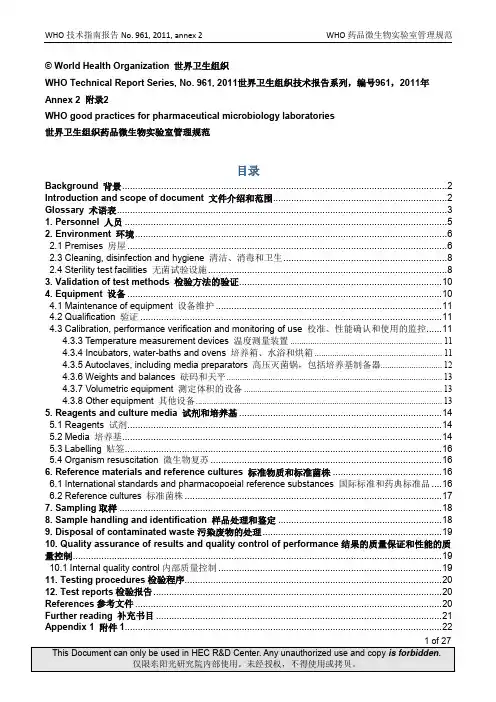
© World Health Organization 世界卫生组织WHO Technical Report Series, No. 961, 2011世界卫生组织技术报告系列,编号961,2011年Annex 2 附录2WHO good practices for pharmaceutical microbiology laboratories世界卫生组织药品微生物实验室管理规范目录Background 背景 (2)Introduction and scope of document 文件介绍和范围 (2)Glossary 术语表 (3)1. Personnel 人员 (5)2. Environment 环境 (6)2.1 Premises 房屋 (6)2.3 Cleaning, disinfection and hygiene 清洁、消毒和卫生 (8)2.4 Sterility test facilities 无菌试验设施 (8)3. Validation of test methods 检验方法的验证 (10)4. Equipment 设备 (10)4.1 Maintenance of equipment 设备维护 (11)4.2 Qualification 验证 (11)4.3 Calibration, performance verification and monitoring of use 校准、性能确认和使用的监控 (11)4.3.3 Temperature measurement devices 温度测量装置 (11)4.3.4 Incubators, water-baths and ovens 培养箱、水浴和烘箱 (11)4.3.5 Autoclaves, including media preparators 高压灭菌锅,包括培养基制备器 (12)4.3.6 Weights and balances 砝码和天平 (13)4.3.7 Volumetric equipment 测定体积的设备 (13)4.3.8 Other equipment 其他设备 (13)5. Reagents and culture media 试剂和培养基 (14)5.1 Reagents 试剂 (14)5.2 Media 培养基 (14)5.3 Labelling 贴签 (16)5.4 Organism resuscitation 微生物复苏 (16)6. Reference materials and reference cultures 标准物质和标准菌株 (16)6.1 International standards and pharmacopoeial reference substances 国际标准和药典标准品 (16)6.2 Reference cultures 标准菌株 (17)7. Sampling取样 (18)8. Sample handling and identification 样品处理和鉴定 (18)9. Disposal of contaminated waste污染废物的处理 (19)10. Quality assurance of results and quality control of performance结果的质量保证和性能的质量控制 (19)10.1 Internal quality control内部质量控制 (19)11. Testing procedures检验程序 (20)12. Test reports检验报告 (20)References参考文件 (20)Further reading 补充书目 (21)Appendix 1 附件1 (22)Examples of zones in which operations could be carried out可进行操作的区域的例子 (22)Appendix 2 附件2 (23)Examples of maintenance of equipment设备维护的例子 (23)Appendix 3 附件3 (24)Examples of calibration checks and intervals for different laboratory equipment不同实验室设备校准检查和间隔的例子 (24)Appendix 4 附件4 (25)Examples of equipment qualification and monitoring设备验证和监控的例子 (25)Appendix 5 附件5 (27)General use of reference cultures 标准菌株的一般用途 (27)Background 背景The WHO Expert Committee on Specifications for Pharmaceutical Preparations adopted in 2009 a revised version of the Good practices for pharmaceutical quality control laboratories (1).世界卫生组织制剂产品的质量标准专家委员会在2009年通过了药品质量控制实验室管理规范的修订版本(1)。

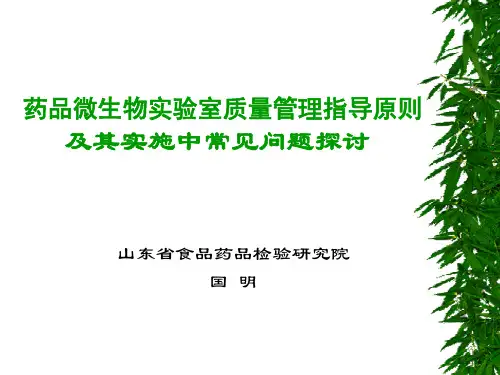
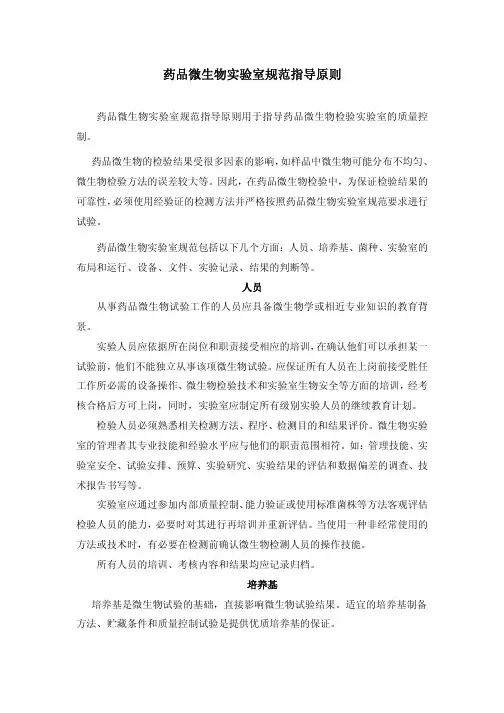
药品微生物实验室规范指导原则药品微生物实验室规范指导原则用于指导药品微生物检验实验室的质量控制。
药品微生物的检验结果受很多因素的影响,如样品中微生物可能分布不均匀、微生物检验方法的误差较大等。
因此,在药品微生物检验中,为保证检验结果的可靠性,必须使用经验证的检测方法并严格按照药品微生物实验室规范要求进行试验。
药品微生物实验室规范包括以下几个方面:人员、培养基、菌种、实验室的布局和运行、设备、文件、实验记录、结果的判断等。
人员从事药品微生物试验工作的人员应具备微生物学或相近专业知识的教育背景。
实验人员应依据所在岗位和职责接受相应的培训,在确认他们可以承担某一试验前,他们不能独立从事该项微生物试验。
应保证所有人员在上岗前接受胜任工作所必需的设备操作、微生物检验技术和实验室生物安全等方面的培训,经考核合格后方可上岗,同时,实验室应制定所有级别实验人员的继续教育计划。
检验人员必须熟悉相关检测方法、程序、检测目的和结果评价。
微生物实验室的管理者其专业技能和经验水平应与他们的职责范围相符。
如:管理技能、实验室安全、试验安排、预算、实验研究、实验结果的评估和数据偏差的调查、技术报告书写等。
实验室应通过参加内部质量控制、能力验证或使用标准菌株等方法客观评估检验人员的能力,必要时对其进行再培训并重新评估。
当使用一种非经常使用的方法或技术时,有必要在检测前确认微生物检测人员的操作技能。
所有人员的培训、考核内容和结果均应记录归档。
培养基培养基是微生物试验的基础,直接影响微生物试验结果。
适宜的培养基制备方法、贮藏条件和质量控制试验是提供优质培养基的保证。
1.培养基的制备培养基可按处方配制,也可使用按处方生产的符合规定的脱水培养基。
在制备培养基时,应选择质量符合要求的脱水培养基或单独配方组分进行配制。
脱水培养基应附有处方和使用说明,配制时应按使用说明上的要求操作以确保培养基的质量符合要求,不得使用结块或颜色发生改变的脱水培养基。
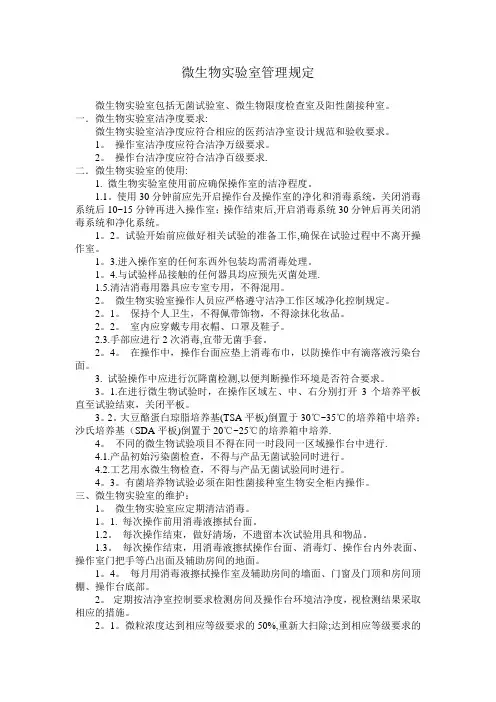
微生物实验室管理规定微生物实验室包括无菌试验室、微生物限度检查室及阳性菌接种室。
一.微生物实验室洁净度要求:微生物实验室洁净度应符合相应的医药洁净室设计规范和验收要求。
1。
操作室洁净度应符合洁净万级要求。
2。
操作台洁净度应符合洁净百级要求.二.微生物实验室的使用:1. 微生物实验室使用前应确保操作室的洁净程度。
1.1。
使用30分钟前应先开启操作台及操作室的净化和消毒系统,关闭消毒系统后10~15分钟再进入操作室;操作结束后,开启消毒系统30分钟后再关闭消毒系统和净化系统。
1。
2。
试验开始前应做好相关试验的准备工作,确保在试验过程中不离开操作室。
1。
3.进入操作室的任何东西外包装均需消毒处理。
1。
4.与试验样品接触的任何器具均应预先灭菌处理.1.5.清洁消毒用器具应专室专用,不得混用。
2。
微生物实验室操作人员应严格遵守洁净工作区域净化控制规定。
2。
1。
保持个人卫生,不得佩带饰物,不得涂抹化妆品。
2。
2。
室内应穿戴专用衣帽、口罩及鞋子。
2.3.手部应进行2次消毒,宜带无菌手套。
2。
4。
在操作中,操作台面应垫上消毒布巾,以防操作中有滴落液污染台面。
3. 试验操作中应进行沉降菌检测,以便判断操作环境是否符合要求。
3。
1.在进行微生物试验时,在操作区域左、中、右分别打开3个培养平板直至试验结束,关闭平板。
3。
2。
大豆酪蛋白琼脂培养基(TSA平板)倒置于30℃~35℃的培养箱中培养;沙氏培养基(SDA平板)倒置于20℃~25℃的培养箱中培养.4。
不同的微生物试验项目不得在同一时段同一区域操作台中进行.4.1.产品初始污染菌检查,不得与产品无菌试验同时进行。
4.2.工艺用水微生物检查,不得与产品无菌试验同时进行。
4。
3。
有菌培养物试验必须在阳性菌接种室生物安全柜内操作。
三、微生物实验室的维护:1。
微生物实验室应定期清洁消毒。
1。
1. 每次操作前用消毒液擦拭台面。
1.2。
每次操作结束,做好清场,不遗留本次试验用具和物品。
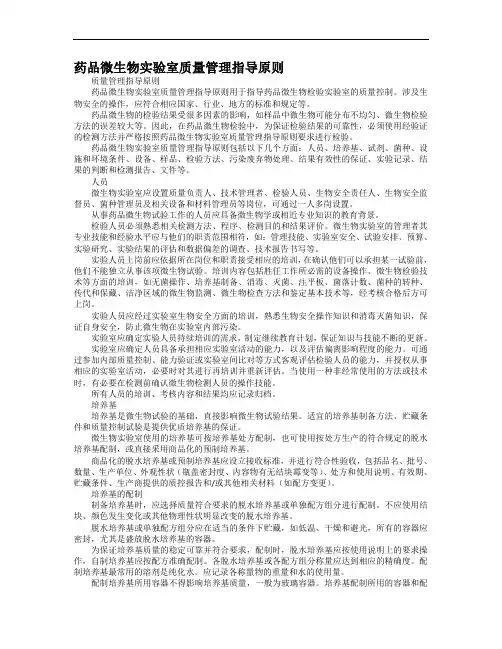
药品微生物实验室质量管理指导原则质量管理指导原则药品微生物实验室质量管理指导原则用于指导药品微生物检验实验室的质量控制。
涉及生物安全的操作,应符合相应国家、行业、地方的标准和规定等。
药品微生物的检验结果受很多因素的影响,如样品中微生物可能分布不均匀、微生物检验方法的误差较大等。
因此,在药品微生物检验中,为保证检验结果的可靠性,必须使用经验证的检测方法并严格按照药品微生物实验室质量管理指导原则要求进行检验。
药品微生物实验室质量管理指导原则包括以下几个方面:人员、培养基、试剂、菌种、设施和环境条件、设备、样品、检验方法、污染废弃物处理、结果有效性的保证、实验记录、结果的判断和检测报告、文件等。
人员微生物实验室应设置质量负责人、技术管理者、检验人员、生物安全责任人、生物安全监督员、菌种管理员及相关设备和材料管理员等岗位,可通过一人多岗设置。
从事药品微生物试验工作的人员应具备微生物学或相近专业知识的教育背景。
检验人员必须熟悉相关检测方法、程序、检测目的和结果评价。
微生物实验室的管理者其专业技能和经验水平应与他们的职责范围相符,如:管理技能、实验室安全、试验安排、预算、实验研究、实验结果的评估和数据偏差的调查、技术报告书写等。
实验人员上岗前应依据所在岗位和职责接受相应的培训,在确认他们可以承担某一试验前,他们不能独立从事该项微生物试验。
培训内容包括胜任工作所必需的设备操作、微生物检验技术等方面的培训,如无菌操作、培养基制备、消毒、灭菌、注平板、菌落计数、菌种的转种、传代和保藏、洁净区域的微生物监测、微生物检查方法和鉴定基本技术等,经考核合格后方可上岗。
实验人员应经过实验室生物安全方面的培训,熟悉生物安全操作知识和消毒灭菌知识,保证自身安全,防止微生物在实验室内部污染。
实验室应确定实验人员持续培训的需求,制定继续教育计划,保证知识与技能不断的更新。
实验室应确定人员具备承担相应实验室活动的能力,以及评估偏离影响程度的能力。
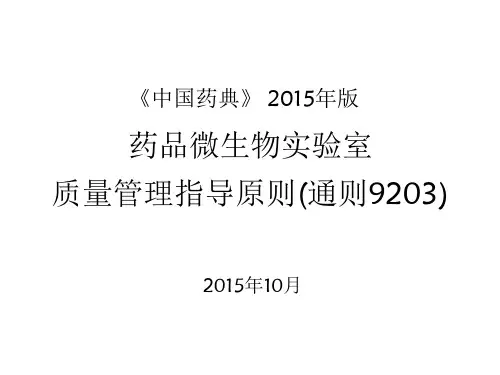

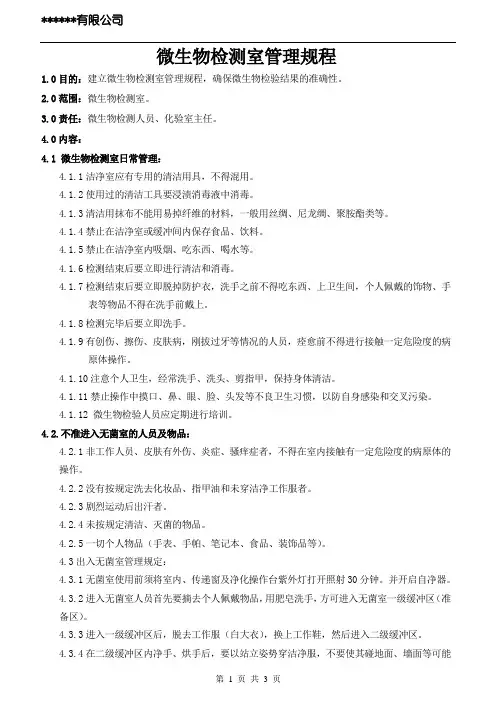
微生物检测室管理规程1.0目的:建立微生物检测室管理规程,确保微生物检验结果的准确性。
2.0范围:微生物检测室。
3.0责任:微生物检测人员、化验室主任。
4.0内容:4.1 微生物检测室日常管理:4.1.1洁净室应有专用的清洁用具,不得混用。
4.1.2使用过的清洁工具要浸渍消毒液中消毒。
4.1.3清洁用抹布不能用易掉纤维的材料,一般用丝绸、尼龙绸、聚胺酯类等。
4.1.4禁止在洁净室或缓冲间内保存食品、饮料。
4.1.5禁止在洁净室内吸烟、吃东西、喝水等。
4.1.6检测结束后要立即进行清洁和消毒。
4.1.7检测结束后要立即脱掉防护衣,洗手之前不得吃东西、上卫生间,个人佩戴的饰物、手表等物品不得在洗手前戴上。
4.1.8检测完毕后要立即洗手。
4.1.9有创伤、擦伤、皮肤病,刚拔过牙等情况的人员,痊愈前不得进行接触一定危险度的病原体操作。
4.1.10注意个人卫生,经常洗手、洗头、剪指甲,保持身体清洁。
4.1.11禁止操作中摸口、鼻、眼、脸、头发等不良卫生习惯,以防自身感染和交叉污染。
4.1.12 微生物检验人员应定期进行培训。
4.2.不准进入无菌室的人员及物品:4.2.1非工作人员、皮肤有外伤、炎症、骚痒症者,不得在室内接触有一定危险度的病原体的操作。
4.2.2没有按规定洗去化妆品、指甲油和未穿洁净工作服者。
4.2.3剧烈运动后出汗者。
4.2.4未按规定清洁、灭菌的物品。
4.2.5一切个人物品(手表、手帕、笔记本、食品、装饰品等)。
4.3出入无菌室管理规定:4.3.1无菌室使用前须将室内、传递窗及净化操作台紫外灯打开照射30分钟。
并开启自净器。
4.3.2进入无菌室人员首先要摘去个人佩戴物品,用肥皂洗手,方可进入无菌室一级缓冲区(准备区)。
4.3.3进入一级缓冲区后,脱去工作服(白大衣),换上工作鞋,然后进入二级缓冲区。
4.3.4在二级缓冲区内净手、烘手后,要以站立姿势穿洁净服,不要使其碰地面、墙面等可能有灰尘的东西。

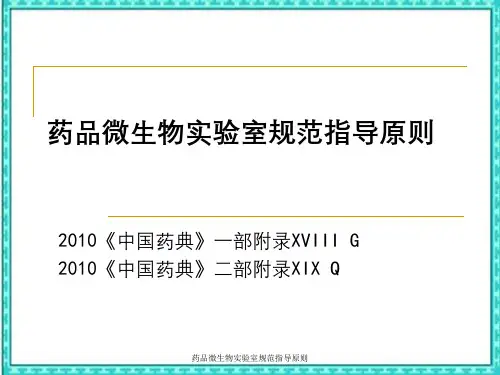
1. 制订/日期QC/主管2. 审核/日期QC/部长3. 批准/日期质量副总经理分发部门:质保部(QA)、质控部(QC)修订历史:版本号修订日期修订概述01 2020.07.02 首次制订实用文档1.0 目的本规程用于规范QC微生物实验室的管理,保证微生物检验工作正常进行。
2.0 范围适用于公司QC微生物实验室的管理。
3.0 职责3.1 本文件由质控部(QC)负责起草,质控部(QC)部长审核,质量副总经理批准;3.2 质控部(QC)负责本规程的贯彻实施,质保部(QA)负责监督检查本规程的执行。
4.0 参考文件《药品质量管理规范》2010年修订;《药品GMP指南—质量控制实验室与物料》;WS/T313-2009《医务人员手卫生规范》。
5.0 定义N/A6.0规程6.1 一般要求6.1.1 从事微生物检验的人员应具备微生物学或相近专业知识的教育背景,并在上岗操作前接受过设备操作、微生物检验技术和实验室生物安全等方面的培训并考核合格。
6.1.2 遵守以下个人卫生和环境卫生规则:(1)更衣区域禁止吃东西、嚼口香糖、吸烟等;(2)保持个人卫生,不得留长指甲和染指甲油以及使用其它可散发粒子的化妆品。
(3)所有与工作无关的个人用品不得带入洁净室,在微生物室操作不得佩戴手表、首饰,洁净服内不得放香烟、食品、钱票等物;(4)微生物实验室应严格消灭苍蝇、蚊虫、老鼠等媒介,防止疫情发生;(5)工作人员入室时,必须穿戴工作衣帽。
离去时脱去工作衣帽,挂于指定地点,并经常洗涤消毒,保持清洁;(6)工作人员操作前后或离开检验室,必须用肥皂或消毒液洗手。
操作前手、工具均要用消毒剂擦拭。
6.1.3 微生物实验室应光线明亮,但避免阳光直射,应有缓冲间,墙面顶棚应光滑平整。
6.1.4严禁使用已污染的灭菌器材和培养基。
如有传染性培养物污染手部,应先用酒精棉球拭去再浸入5%甲酚或1%的新洁尔灭等消毒液内片刻,再用肥皂清水彻底洗刷干净。
工作衣、帽、口罩等受到菌液实用文档污染时,应立即脱去翻转包裹,使污染部分包在内部送往消毒,高压蒸汽灭菌后洗涤。
微生物试验室质控管理制度第一章总则第一条目的本制度的目的是为了规范微生物试验室的质控管理,保障患者的安全和医疗质量,提高试验室的运行效率和组织管理本领。
第二条适用范围本制度适用于医院内的微生物试验室,包含试验室的设备、人员和样本等方面的管理。
第三条管理原则微生物试验室的质控管理应遵从以下原则: 1. 严格依照国家相关法规和行业标准执行; 2. 强化质量意识,重视细节,确保试验室操作的准确性和可靠性; 3. 定期进行质量检查和质量评估,及时发现问题并采取措施改进; 4. 加强员工培训,提高技术水平和专业素养;5. 加强与其他科室的沟通与合作,促进共同发展。
第二章设备管理第四条设备购置1.设备购置应依据试验室需求和技术要求进行合理选型,并严格依照国家质量标准执行;2.设备购置前需进行市场调研、技术评估和报价比较,确保购置的设备性价比合理;3.设备购置需经过试验室负责人批准,并做好设备档案管理。
第五条设备验收1.设备验收应由试验室负责人组织,并邀请相关技术人员参加;2.设备验收内容包含设备是否符合技术要求、运行稳定性、安全可靠性等方面的评估;3.设备验收合格后,方可投入使用,并进行设备跟踪及日常维护。
第六条设备维护1.试验室应订立设备维护计划,并进行定期保养和维护;2.设备的保养和维护工作由专人负责,保养记录应认真记录设备名称、操作内容和日期;3.设备显现故障时,应及时采取维护和修理措施,并记录维护和修理过程和结果;4.定期对设备进行校准和验证,确保设备的准确性和可靠性。
第七条设备报废1.设备报废应依据国家相关法规执行,试验室负责人组织进行;2.设备报废前需进行评估,确保设备无法连续使用,并做好报废手续和记录;3.报废设备的有害物质应妥当处理,不得随便丢弃。
第三章人员管理第八条人员配备1.试验室的人员配备应合理,确保试验室的正常运转;2.招聘人员应符合岗位要求,经过面试、体检和考核合格后方可录用;3.人员录用后应进行岗前培训,并签订劳动合同。
© World Health Organization 世界卫生组织WHO Technical Report Series, No. 961, 2011世界卫生组织技术报告系列,编号961,2011年Annex 2 附录2WHO good practices for pharmaceutical microbiology laboratories世界卫生组织药品微生物实验室管理规范目录Background 背景 (2)Introduction and scope of document 文件介绍和范围 (2)Glossary 术语表 (3)1. Personnel 人员 (5)2. Environment 环境 (6)2.1 Premises 房屋 (6)2.3 Cleaning, disinfection and hygiene 清洁、消毒和卫生 (8)2.4 Sterility test facilities 无菌试验设施 (8)3. Validation of test methods 检验方法的验证 (10)4. Equipment 设备 (10)4.1 Maintenance of equipment 设备维护 (11)4.2 Qualification 验证 (11)4.3 Calibration, performance verification and monitoring of use 校准、性能确认和使用的监控 (11)4.3.3 Temperature measurement devices 温度测量装置 (11)4.3.4 Incubators, water-baths and ovens 培养箱、水浴和烘箱 (11)4.3.5 Autoclaves, including media preparators 高压灭菌锅,包括培养基制备器 (12)4.3.6 Weights and balances 砝码和天平 (13)4.3.7 Volumetric equipment 测定体积的设备 (13)4.3.8 Other equipment 其他设备 (13)5. Reagents and culture media 试剂和培养基 (14)5.1 Reagents 试剂 (14)5.2 Media 培养基 (14)5.3 Labelling 贴签 (16)5.4 Organism resuscitation 微生物复苏 (16)6. Reference materials and reference cultures 标准物质和标准菌株 (16)6.1 International standards and pharmacopoeial reference substances 国际标准和药典标准品 (16)6.2 Reference cultures 标准菌株 (17)7. Sampling取样 (18)8. Sample handling and identification 样品处理和鉴定 (18)9. Disposal of contaminated waste污染废物的处理 (19)10. Quality assurance of results and quality control of performance结果的质量保证和性能的质量控制 (19)10.1 Internal quality control内部质量控制 (19)11. Testing procedures检验程序 (20)12. Test reports检验报告 (20)References参考文件 (20)Further reading 补充书目 (21)Appendix 1 附件1 (22)Examples of zones in which operations could be carried out可进行操作的区域的例子 (22)Appendix 2 附件2 (23)Examples of maintenance of equipment设备维护的例子 (23)Appendix 3 附件3 (24)Examples of calibration checks and intervals for different laboratory equipment不同实验室设备校准检查和间隔的例子 (24)Appendix 4 附件4 (25)Examples of equipment qualification and monitoring设备验证和监控的例子 (25)Appendix 5 附件5 (27)General use of reference cultures 标准菌株的一般用途 (27)Background 背景The WHO Expert Committee on Specifications for Pharmaceutical Preparations adopted in 2009 a revised version of the Good practices for pharmaceutical quality control laboratories (1).世界卫生组织制剂产品的质量标准专家委员会在2009年通过了药品质量控制实验室管理规范的修订版本(1)。
During the inspections carried out when prequalifying laboratories, the inspectors had noticed that some of the texts of these guidelines might benefit from additional guidance, with a special focus on microbiology.在预验证实验室时所进行的检查过程中,检查官注意到这些指导原则的部分内容可能受益于附加的特别关注微生物的指导原则。
In light of the above, the Expert Committee recommended that the WHO Secretariat initiate the process of developing a new text on good practices for pharmaceutical microbiology laboratories.鉴于以上,专家委员会建议世界卫生组织秘书处启动撰写新的药品微生物实验室管理规范的程序。
The following text is proposed to cover this specific type of laboratory.提出下文以包含这种特殊类型的实验室。
Introduction and scope of document 文件介绍和范围Pharmaceutical microbiology laboratories may be involved in:药品微生物实验室可涉及到:— sterility testing; 无菌试验;—detection, isolation, enumeration and identification of microorganisms (bacteria, yeast and moulds) and testing for bacterial endotoxins in different materials (e.g. starting materials, water), products, surfaces, garments and the environment; and—在不同物料(如原辅料、水)、产品、表面、外衣和环境中的微生物(细菌、酵母菌和霉菌)的检测、分离、计数和鉴别,以及细菌内毒素的检验;—assay using microorganisms as part of the test system.—使用微生物作为检验系统的一部分进行含量测定。
These guidelines relate to all microbiology laboratories involved in the above-mentioned testing activities, whether they are independent or a department or unit of a pharmaceutical manufacturingfacility.这些指导原则有关于所有在上述检验活动中涉及的微生物实验室,无论它们是独立的或是药品生产厂的一个部门或单位。
These guidelines are based on and supplement the requirements described in Good practices for pharmaceutical quality control laboratories(1); General guidelines for the establishment, maintenance and distribution of chemical reference substances. Revision(2); The International Pharmacopoeia, Fourth Edition (3); First Supplement to The International Pharmacopoeia, Fourth Edition (4); and ISO/IEC 17025 (5).这些指导原则是建立在以下规定的要求的基础上的,并对其进行补充:药品质量控制实验室管理规范(1);建立、维护和分发化学标准品的通用指导原则(2);国际药典,第四版(3);国际药典的第一附录,第四版(4);和ISO/IEC 17025 (5)。
Glossary 术语表calibration 校准The set of operations that establish, under specified conditions, the relationship between values indicated by an instrument or system for measuring (especially weighing), recording and controlling, or the values represented by a material measure, and the corresponding known values of a reference standard. Limits for acceptance of the results of measuring should be established.在规定条件下建立一台测量(特别是称量)、记录和控制的设备或系统所显示的值,或一个实物量具所代表的值和相应的标准品的值之间关系的一套操作。